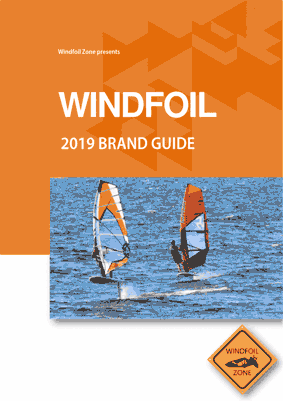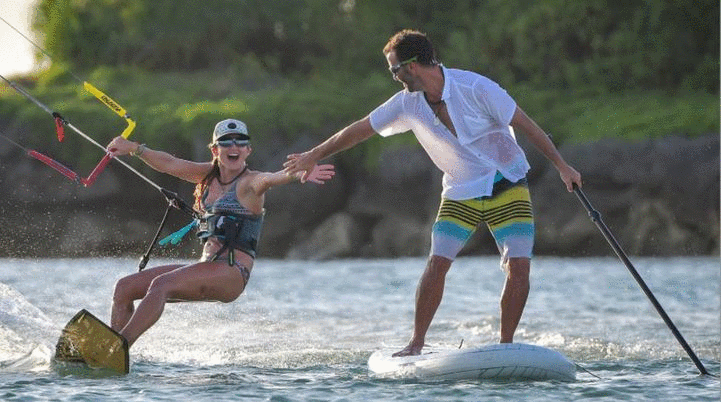Strapless foiling - Learning to fly without straps
- Tez Plavenieks
- Feb 1, 2020
- 4 min read
Updated: Aug 8, 2020
Written by Tez Plavenieks
As editor of two successful magazines (SUP Mag UK and Windsurfing UK) it’d be foolhardy to pass off the foiling movement as purely faddy. As anyone following these two sports closely will know 2017 is when foiling truly landed and is now the word of the moment.

Conducting in depth equipment tests is one of the things I do regularly and as more and more foils came to market at the start of the year it was time to get involved and see what all the fuss was about.
Having done a bit of background research I came to the conclusion that I should look at AHD first as it was they who’d successfully brought foiling to market over ten years ago. Already having a good relationship with the brand I was soon in possession of their AFS-1 foil and dedicated Shark foiling board.
While I didn’t consider for one minute I was just going to ‘plug’ straight in to windsurf foiling it took a while to actually get going – literally. With little info to hand figuring out things like what rig to use in which wind strength were a head scratch. During the course of a few months, however, I got to grips with taking off and flying short distances.
Keen to progress my own personal foiling experiences, and see what else was on offer, I was then passed the brand’s Sealion Wings 7”6’. Initially this was to be used for SUP foiling but as it can also accommodate a rig it made sense to check out the Sealions’s wind foiling attributes.
Watch also: Benjamin Tillier goes Strapless
Compared to the Shark the Sealion is a much different beast. Firstly it’s a multi-discipline board – windSUP, SUP surfer, SUP foil and wind foil. And secondly there aren’t any foostraps or inserts. To those new to foiling this may be at odds with what’s currently being promoted, yet footstraps aren’t actually needed. And in fact, as I write, a number of other companies now produce windy foil platforms without.

Another thing to point out is the Sealion is smaller, in terms of dimensions, than the Shark. Narrower and slightly lower volume it’s actually an easier and less technical board to foil, however. All Sealions are manufactured with user friendliness in mind. Whereas the Shark is more slalom orientated the Sealion is very much a free foiler in windy mode.
And not having a deck cluttered with straps means foot placement can be dialled in more effectively. The rider (In this case me) learning process is therefore more efficient and in depth as you gain understanding about placement subtle nuances required to effectively pilot a foil board.
Some promote the fact that wide boards are easier to learn the basics of foiling on and while this may be true I found quicker success having a reactive board that required fast muscle memory development. Now don’t get me wrong. I’m not suggesting I’m a legend at foiling – I’m not! It’s just that learning aboard the SL was more suited to how I glean information. It may therefore not be for everyone.

I’ll whole heartedly agree that you don’t get as much leverage over the foil with narrower boards. And as such you’re even more upright than normal. You also end up being quite far forwards and towards the centre line on the Sealion, much like being on a surfboard or SUP but with while holding a rig.
Short harness lines and high booms are the best setting for more freerace/slalom orientated foil boards whereas the Sealion commands longer harness lines and a lower boom due to the differing stance.
I should also talk a bit about the AFS-1 foil. It’s an established design that looks slightly different to foils coming out currently. The front wing in particular is chunky. Designed for super early lift it’ll take off quickly and concentration is needed to not over foil.
Again, this is easy to get used to after a few sessions and puts riders in a good place for further flying antics with alternative equipment. Developing the ‘feel’ is how progression will be achieve and feel is most definitely acquired using this gear.
That’s not say it’s hard – it isn’t in fact. The Sealion Wings 7.6ft and AFS-1 foil simply requires a touch more concentration at the start. I’ve had this set up out flying in 22 knots which is easily doable with riders steadily building up to the same over time.
You certainly hit a ceiling with the AFS-1 foil but with a number of on the water sessions most low to medium wind strengths can be flown in without issue.

And what about manoeuvres I hear you ask. Well, gybing is slightly trickier than with straps, as again, you don’t really have as much leverage without. You have to approach corners as you would SUP foiling.
Teasing the Sealion round by looking in the direction of travel, a really early rig change and deft footwork yield best results. Concentration needs to be given so as to not over foil during the transition. Following a degree of trial and error riders should get there though.
Learning to wind foil on a strapless board has been a great experience and one I’d recommend. Allowing for the development of necessary and subtle flying skills I’ve now been able to transition to other kit efficiently. If you’re contemplating getting involved in foiling for the first time then I’d recommend this route as a way to progress.
As stated earlier it may not be for everyone but it worked in my case.
Tez Plavenieks
Editor, Windsurfing UK
Editor, SUP Mag UK
Action sports content creator - tezplavenieks.com
Read also our other posts about strapless windfoiling:
Interview with Dominique sharing his experience and tips to get started with strapless windfoiling. Check it out, or watch his video below.
Here is another interview of Benjamin Tillier foiling strapless in Nouméa. Check it out!
The pros and cons of strapless foiling.









Comments